By T. Sabaratnam, July 19, 2004
Chapter 9
Original index to series
Original Chapter 10
The Overt Track
The second fortnight of August 1983 is as important to the Tamil freedom struggle and the history of Sri Lanka as the last ten days of July and the first 17 days of August. Indira Gandhi put into action during these two weeks her two-track policy: overt diplomatic initiative and covert training and arming of Tamil militant groups.
Jayewardene also launched his counter three-track policy during these days: buy time through negotiations to build the military machine, weaken the moderates, isolate the militants, destroy the Tamil freedom struggle by describing it to the world as a terrorist problem and destroy the territorial base of Tamil Eelam.
Indira Gandhi commenced her overt diplomatic offensive with her third telephone call of 17 August. Press Trust of India (PTI) correspondent P. Dharmarajah, who was in the group of journalists that was interviewing Jayewardene when the third call came, told me they tried to gauge Jayewardene’s reaction to Indira Gandhi’s intervention. Dharmarajah said, “The old man sounded bitter, but helpless. He encapsulated his resentment and helplessness with the comment, ‘We are a small nation and will have to endure these things. Perhaps this is the fate of all small nations.’ ”
Jayewardene told the reporters that he would report Indira Gandhi’s call to the cabinet, which he did the following Wednesday, 24 August. Gamini Jayasuriya, Gamini Dissanayake, R. Premadasa and Ranjith Atapattu opposed Indian mediation.
Jayasuriya was the most vociferous. He said, “If we accept India’s good offices we won’t be able to walk the streets.”
This provoked Jayewardene. He retorted, “Mrs. Bandaranaike is saying India should mediate. She says the government should talk to the terrorists and she says Parthasarathy should be invited to Colombo and yet she is allowed to walk on the streets without any problem.”

Chelliah Rajadurai
Premadasa took up the position that the Tamil problem was an internal one and Indian intervention amounted to the violation of Sri Lanka’s sovereignty. “Let’s talk to the Tamils and find our solution. India should be kept out of this affair,” he said. He pointed to Devanayagam and Rajadurai and said, “Let’s talk to them and settle the matter.”
Devanayagam quipped, “Then you will have to give more than what you were prepared to give the TULF.”
Jayewardene listened to the objections and announced he had already agreed to Parthasarathy’s visit. He added that Parthasarathy had already begun the consultation process with the TULF and he would be in Colombo the following day.
Indira Gandhi picked Parthasarathy for this key assignment because he was a skilled negotiator and her trusted advisor, a constitutional expert who had experience in similar conflict resolution exercises and because he was a Tamil and would be sensitive to Tamil aspirations and would be acceptable to Tamil Nadu leaders. He had tremendous experience in negotiating settlements in knotty problems concerning Kashmir, Mizoram and Vietnam.
Alternate Solution
Parthasarathy, whose brief was to bring round the Jayewardene government to meet the legitimate aspirations of the Tamil people, commenced his work immediately. He summoned TULF leaders to Delhi to hear their case. Amirthalingam told reporters at Chennai airport that he welcomed India’s mediation and Indira Gandhi’s use of the word ‘united’ in her report to parliament. He also said the TULF agreed to look at an alternate to separation in deference to the wishes of India, but would not drop its separation demand until the alternate solution is accepted. He told them bluntly that Tamils expected India to send troops to protect them if more riots occurred.
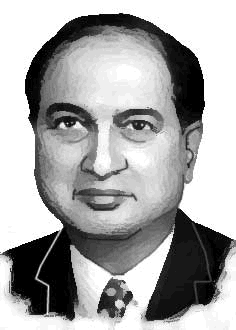
G. Parthasarathy
Amirthalingam said, “It’s not the Tamils who are splitting Sri Lanka. It’s the actions of the Sinhala mobs and the policies of the government that are splitting the country. We are only asking for the de jure recognition of the existing reality.”
Amirthalingam and Neelan Tiruchelvam told me that the meetings with Parthasarathy were highly productive. Parthasarathy told TULF leaders, “Now that you have agreed to look at an alternate solution, tell me the basis of the solution that you expect? Spell that out clearly. That would be your negotiating position.”
Parthasarathy laid down four guidelines. They were,
· The Tamil negotiating position should be guided by internally consistent principles, not based on the expediency of the moment.
· It should be short of the ultimate demand of a separate state, while being responsive to Tamil aspirations.
· The substance of the Tamil demands should be capable of being woven into a scheme without the emotive content or terminology which would trigger Sinhala resistance.
· The scheme the Tamils present should acknowledge the unity, sovereignty and territorial integrity of Sri Lanka.
The TULF leadership met Parthasarathy in two days with their draft. However, Parthasarathy was not satisfied. He objected to the use of the phrase, ‘Union of States.’ He said that phrase connoted a full-fledged federal structure which the Sinhalese totally opposed. He told the TULF that, since Dudley Senanayake had accepted the word ‘Regions,’ they should use that word. He persuaded the TULF to alter the draft to use the phrase ‘Union of Regions.’ He got the TULF to reformulate the draft to acknowledge the unity, sovereignty and territorial integrity of Sri Lanka.
Parthasarathy also told the TULF leaders that they should not confine their attention to regional matters only. He told them that Tamils would need to share power at the centre if they were to join the mainstream of national development. He suggested that the TULF include in its scheme provisions for a proportionate share in the recruitment to the armed services, police and public service.
Armed with the TULF’s reformulated draft, the product of one week of labour, Parthasarathy arrived in Colombo on 25 August. He called on Jayewardene that very evening. He told Jayawardene of the meetings he had had with the TULF which resulted in the formulation of the Tamil negotiating position. He handed over to Jayewardene the TULF draft and requested the government’s negotiating position.
Jayewardene told him that his party, the UNP, had identified the Tamil grievances before the 1977 election by talking to the TULF with the help of Thondaman. His government was implementing measures to remove those grievances. He explained the background for the July riots and blamed the TULF, armed groups and Leftists for it. He emphatically said his government and the people would never permit the division of the country. Strengthening and full implementation of the District Development Councils scheme was all that he could do and that could be considered the government negotiating position, he said.
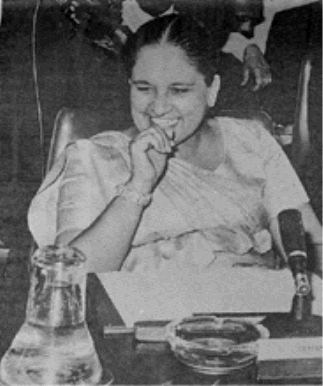
Sirimavo Bandaranaike
Parthasarathy next met Sirimavo Bandaranaike. She declared unequivocally that Sri Lanka should remain a unitary state. She ruled out any form of federalism to accommodate the aspirations of the Tamils.
Jayewardene, who met Parthasarathy for the second time after Parthasarathy’s meeting with Sirimavo Bandaranaike, told him, “Now you would have known the negotiating position of the Sinhala people. The government and the main opposition have one common stand: the solution should not violate the unitary nature of the state. That is the basic negotiating position of the Sinhala people. The government is prepared to strengthen and fully implement the District Development Council scheme. That is the highest the government can go,” Jayewardene repeated.
Jayewardene told Parthasarathy that the Sinhala people would never agree to any special constitutional scheme or structure to solve the Tamil problem. A solution to the Tamil problem should be found within a general scheme applicable to the entire country. Parthasarathy grasped the appropriateness of Jayewardene’s assessment and commented about it when he met his Cambridge University friend Pieter Kueneman on 26 August. He told Kueneman that Sinhala and Tamil perceptions of the problem not only differed vastly but were deeply embedded in their respective psyches. “I don’t see any common ground left,” he told a group of Cambridge Fellows, F. C. de Saram, with whom he played cricket in their younger years, and Raju Coomaraswamy.
Discovering Common Ground
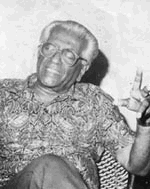
Dr. Colvin R. de Silva
Parthasarathy decided that his effort would be to discover whatever common ground was still available among the Sinhalese and Tamils and to build on that. On this voyage of discovery he met ministers Thondaman, Lalith Athulathmudali and Gamini Dissanayake, Dr. Colvin R. de Silva and Bernard Soysa of the LSSP and Pieter Kueneman of the Communist Party.
Parthasarathy’s third meeting with Jayewardene was a wrap-up in which they discussed the strengthening of the DDCs. They identified some of the powers that could be devolved to the DDCs. Jayewardene told Parthasarathy to prepare a scheme for discussion at the next meeting, which he skillfully avoided fixing.
On his way back to New Delhi, Parthasarathy called on M. G. Ramachandran, chief minister of Tamil Nadu where an intense debate on the Parthasarathy Mission to Colombo was in progress. D. M. K. leader M. Karunanithi, who had resigned from the Opposition Leader post early that month, was trying keep up the momentum of the protest. He said talks with Jayewardene were useless and a Bangladesh-style Indian intervention was the only way to protect the Sri Lankan Tamils. MGR took Indira Gandhi’s side. He argued that the matter should be resolved peacefully through talks.
MGR ordered Q Branch, the intelligence unit of the Tamil Nadu Police, to keep a tab on Karunanithi’s activities and to bring him in touch with the Sri Lankan Tamil militant leadership, which the police did.
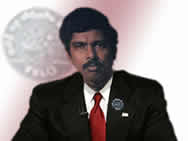
Sri Sabaratnam
When riots erupted in Sri Lanka, Tamil militant groups had their presence in Tamil Nadu. The LTTE was close to Nedumaran and his Kamaraj Congress. Pirapaharan and most of the leaders were in Jaffna and did not have a proper office in Chennai. TELO was close to the DMK and its leadership. TELO leader Sri Sabaratnam, who was in Tamil Nadu, met Karunanithi regularly. PLOTE was in contact with the AIADMK and its leader MGR through minister S. D. S. Somasundaram. PLOTE leader Uma Maheswaran was in Chennai and enjoyed some governmental favours like accommodation in the MLA’s hostel and land for opening a training centre in Tamil Nadu. The EPRLF was close to Naxilite groups in Tamil Nadu and Andhra, especially Kothandaraman’s People’s War Front. The EPRLF’s leader Pathmanabha was in Jaffna.
Parthasarathy met with Karunanithi. He briefed him of the situation in Sri Lanka and said restoring ethnic harmony in Sri Lanka was a highly sensitive issue. He told him that Tamil Nadu politicians should act and talk with responsibility. “Every word uttered here is having its repercussion in Sri Lanka,” he warned.
Parthasarathy briefed the TULF leaders about his discussions in Colombo and invited them to Delhi for a meeting with Indira Gandhi. The meeting took place on 5 September. “That was a very interesting and educative meeting,” Amirthalingam told me in Colombo in January 1984 when he came to attend the All Party Conference (APC).
He said Indira Gandhi again reiterated India’s Sri Lanka policy. She said India was fully committed to helping the Tamils to attain their aspirations; self rule in the areas where they are a majority within a united Sri Lanka. She told the TULF leaders firmly, “You must abandon your goal of a separate state.”
For two hours, she and her advisors, Alexander and Parthasarathy, went over the world scene where similar freedom struggles were on. They looked at the various constitutional models and structures adopted or considered in those countries as solutions. Alexander suggested the Indian Union territory as a model. Indira Gandhi shot that down and suggested Indian states could serve as the model for Sri Lanka.

Dr P C Alexander (left), Principal Secretary to Prime Minister of India, Indira Gandhi receives special Emissary of Sri Lanka’s President H W Jayewardane in New Delhi on August 9, 1983.
Indira Gandhi told the TULF of Karunanithi’s Chennai speech the previous day and said, “Now you see the danger of your separatist demand. That might lead the DMK to revive the demand for a Dravidian State,” she said. Karunanithi, in his speech, had said that, though his party had given up its plan for the separation of Tamil Nadu from India in 1962, the reasons that had prompted that demand remained valid. He attacked India Gandhi for not showing enough interest in Sri Lankan Tamils. “Not a dog barked when the Tamils were massacred in Sri Lanka,” Karunanithi said.
Amirthalingam told the Delhi press after that meeting that the TULF was prepared to negotiate with the Sri Lankan government through Indian mediation. “The mission of G. Parthasarathy has positively created a movement towards finding a solution to the Tamil problem,” he said. He said India should not be satisfied with merely offering its good offices. India should play an active role, the role of a mediator.
In Colombo, the situation was different. Jayewardene was trying to wriggle out of Indian mediation. He was specially trying to edge out Parthasarathy. As was his custom, he made use of the media under his control to create an atmosphere hostile to Parthasarathy’s mediation. He adopted two lines of attack. The first was that, as a Tamil, Parthasarathy was favouring the Tamils. Suggestions were made that India should appoint a non- Tamil, preferably a north Indian for this task. The second was that Parthasarathy was trying to get for the Tamils regional councils which the Sinhala people had rejected. All that the Sinhalese could agree on was strengthened District Development Councils (DDCs). Prime Minister Premadasa was tasked to commence a campaign, ‘DDC and No More.’
Attacks on Parthasarathy were part of Jayewardene’s 3-track policy to counter Indian intervention. I will deal with that in detail in Chapter 12. In this Chapter I will relate the outcome of Indira Gandhi’s track one, the Parthasarathy mission. Jayewardene’s attack on Parthasarathy, the Batticoloa jail-break, the propaganda onslaught on Amirthalingam aimed at the weakening of the moderate Tamil leadership and the Maduru Oya invasion diverted most of the attention of the Jayewardene government, India and the Tamil leadership from the Parthasarathy mission during the months of September and October. During these months, Amirthalingam and other TULF leaders realized the erosion of their popular support and gradually accepted the position that the militants have come to play an important role in attaining the aspirations of the Tamil people.
In an important statement issued in the later part of October Amirthalingam shifted his position about the role of the militants. Amirthalingam said that, if Jayewardene refused to negotiate with them through Indian mediation, he would have to talk to the militants. He also said, even if Jayewardene talks to the TULF, the solution “should be acceptable to the Liberation Tigers.”
Amirthalingam’s statement, for the first time, acknowledged the primacy of the LTTE among the militant groups. That was at a time when PLOTE was considered the biggest militant organization and TELO was considered close to India. From then on the LTTE emerged into the forefront of the Sri Lankan Tamil freedom struggle.
India also was contributing to that situation. I will devote the next Chapter to Indira Gandhi’s covert track – the training and arming Tamil militant groups. The decision to train and arm Tamil militants was made soon after Narasimha Rao reported about his visit on the Sri Lankan situation to Indira Gandhi. The ‘love’ Jayewardene sent to Indira Gandhi through Rao was the immediate provocation. Indira Gandhi and her planners decided that Jayewardene, the old fox as they called him, could only be brought to his knees through destabilization. They decided to make use of the Tamil militant groups to pressurize Jayewardene.
India kept Amirthalingam in the dark about its training program. But Amirthalingam realized that the militants were becoming more aggressive and the Jayewardene government was trying its utmost to weaken him and the TULF. He told the Chennai media on his return from the September 5 Delhi meeting that the militants were emerging as an important factor and compared them to Bhagat Singh of the Indian freedom struggle. He said the militants were not “terrorists’ as Jayewardene wanted to make them out. That was the outcome of Amirthalingam’s realization of Jayewardene’s second policy track of marginalizing the moderates and destroying the militants militarily and describing them to the world as terrorists.
JR Drags His Feet
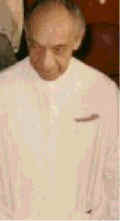
JR Jayawardene
Jayewardene’s strategy to delay the Parthasarathy mission pushed Amirthalingam and the TULF into a tight corner. Amirthalingam, who went to Europe at the beginning of October, was criticized by his supporters for agreeing to talk to the Jayewardene government through India’s mediation. He was blamed for not pressing Indira Gandhi to militarily intervene in Sri Lanka. He was also blamed for allowing Jayewardene time to build up the army and repeat a July 1983 pogrom.
Amirthalingam told Indira Gandhi the views conveyed to him by expatriate Tamils when he met her on 17 October while returning from Europe. Indira Gandhi told Amirthalingam and his two colleagues, Sivasithamparam and Sampanthan, who flew from Chennai to join the meeting, to be patient. She did not explain. But Parthasarathy, in a private discussion after the meeting with Indira Gandhi, briefed the TULF leaders of India’s concerns. He said India could not afford to earn the name of a bully. India wanted to be accepted as the regional power in South Asia. The policy India followed – the policy of offering its good offices to work out a solution to the Tamil problem – had won the acceptance of the international community, Parthasarathy said. “No country has questioned our right to help Jayewardene to sort out the Tamil problem. That means they have accepted our regional dominance. Give us some time. We will help you to win your rights,” Parthasarathy said.
Indira Gandhi’s concern during the 17 October meeting zeroed in on three matters. The first was the realization of Tamil rights within a united Sri Lanka. During the lengthy analysis of that matter two issues received her consideration: the impact of the Sixth Amendment to the Constitution enacted on 4 August and the revival of the Parthasarathy mission.
The TULF had decided not to take the oath of loyalty required by the Sixth Amendment and they would lose their membership of parliament in three days, on 20 October, the last day the parliament sat within the mandatory 3-month period available for a member of parliament to take his oath of allegiance. The TULF losing their seats in parliament would result in the total estrangement of the Tamil community from the Sri Lankan state. Indira Gandhi wanted to prevent such estrangement by working out a reasonable solution to the Tamil problem through Parthasarathy. For Parthasarathy to continue his effort Jayewardene had to be pressurized to invite Parthasarathy to continue his mission.
The second matter that received Indira Gandhi’s attention was the Maduru Oya invasion. Amirthalingam brought that to her notice. I will deal with that matter in detail in a separate Chapter.
The third was India’s foreign policy dimension; the induction of external forces inimical to India. The matter, as I pointed out earlier, received New Delhi’s attention with Jayewardene’s request for arms from countries other than India. Though the US and UK declined to give arms to Sri Lanka, the US followed an active policy of bringing Sri Lanka into its orbit.
Dispute over the VOA
India was incensed when on 9 August 1983 Sri Lanka signed a revised agreement with the US for the building of the new Voice of America (VOA) broadcasting facility and the installation of one powerful 500 Kw and three 250 Kw shortwave transmitters with a very wide reach. The new broadcasting station had the capacity to cover the entire Indian subcontinent, the Arab world, parts of China, Soviet Central Asia, Afghanistan, Iran and East Africa. And its objective was propaganda.
Indira Gandhi called the new VOA station “the second American base in Sri Lanka.” The first base was Trincomalee harbour.
India conveyed its objections to Colombo and Washington. The Sri Lankan foreign ministry dismissed India’s objection, saying the new agreement was only a revision of the old agreement signed between the two countries in 1951 and the agreement had been renewed since then several times over the years.
India declined to treat the matter so lightly. It said the new transmitting facility was the only one the US built outside its territory and was powerful enough to jam any other broadcast in the region with links to communication satellites. The Indian foreign ministry in a statement said, “the proposed relay station is reportedly the most powerful outside the US and its range is likely to cover the whole of the Indian subcontinent and the neighboring countries.” The Soviet Union also reacted strongly.
The Indian Foreign Ministry spokesman released the text of the Indian statement in the evening media meeting. Reporters questioned the spokesman about Indira Gandhi’s comment which called the VOA “the second US base in Sri Lanka.”
The spokesman’s response was, “It is more than a base.” The spokesman, who had come prepared to answer that question, distributed copies of a story published by the Washington Post. The story, scooped by its leading journalist Murray Marder, was headlined “Nicolaides Memorandum.” The memorandum, prepared by VOA deputy director Nicolaides, said the VOA was not a journalistic enterprise. “We are, as all the world understands, a propaganda agency.”
The memorandum said the VOA would start broadcasts in regional languages. The important paragraph in the memorandum read; “We must promote disaffection between peoples and rulers, underscoring the denial of rights, inefficient management, corruption, indifference to the real needs of the people, suppression of cultural diversity and religious persecution.”
The spokesman said Indira Gandhi had advisedly called the VOA a base. “She considers the VOA an ideological and propagandist base,” he said.
Colombo went ahead with the implementation of the agreement and gifted 800 acres of prime coconut property at Iranwila in Nattandiya despite local protest for the VOA facility.
The signing of the VOA agreement was followed by the visit to Sri Lanka of US Defense Secretary Casper Weinberger on 1 October 1983. The US played down Weinberger’s visit, saying that he stopped over for tea, but Indian High Commission sources in Colombo said that he had come with the special purpose of assuaging the injured feelings of Jayewardene who had conveyed to the US administration his disappointment over its failure to help him when in need. Indian sources said military assistance formed part of Weinberger’s discussion while in Colombo. Jayewardene was not mollified. He kept complaining that the US had let him down.
Walters Mission
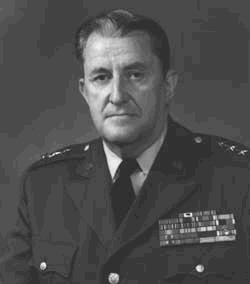
Vernon A. Walters
President Reagan sent Lieutenant-General Vernon A. Walters, one of his troubleshooters, as his special envoy to meet Jayewardene. He visited Colombo in the latter part of October, after Indira Gandhi’s October 17 meeting with Amirthalingam. Walters was a senior official in the US strategic and intelligence department who had earned the reputation of undertaking sensitive missions for President Regan. Indian foreign ministry treated him as the architect of the anti-Indian policy on matters of Indian security.
Walters held a lengthy one-to-one discussion with President Jayewardene. Walters had told Jayewardene’s biographers KM de Silva and Howard Wriggins that he explained to Jayewardene “the narrow limits within which US has to operate with India.”
“Walters recalled that he advised the president to continue with his negotiations with the Tamil separatist groups and with India, and also expressed his fears that India might well take stronger measures, a hint of a possible military intervention, if the Sri Lankan situation deteriorated further, by which he appeared to mean further outbreaks of ethnic violence,” they wrote in J R Jayewardene of Sri Lanka: A Political Biography – Volume Two: From 1956 to His Retirement (1989).
New Delhi refused to believe that a high ranking official was sent to Colombo just to assuage the feelings of Jayewardene. J N Dixit, in his book Assignment Colombo says this about the thinking in Delhi.
“Walters gave detailed information to Mr. Jayewardene about India providing training and other logistical facilities to Sri Lankan Tamil separatists in India. He also agreed to act as an intermediary between Sri Lanka and Israel to ensure Israeli arm supplies and intelligence support to the island nation. The quid pro quo suggested by Walters was that Sri Lanka strategic intelligence gathering facilities against India in the proposed Voice of America broadcasting station be established in that country. Walters also agreed to facilitate the employment of British mercenaries and Pakistani military officers to support and assist Sri Lankan security forces. India had confirmed information about the discussions Walters had on Sri Lanka, both in Colombo and in Washington.”
Indira Gandhi told the media after her 17 October meeting with Amirthalingam that a dangerous situation was developing in Sri Lanka, as the TULF parliamentarians were about to lose their seats in parliament. She said Colombo was deliberately dragging its feet and delaying negotiations. She announced that she would soon send Parthasarathy to restart the talks.
When Gandhi made this announcement, Jayewardene had not yet invited Parthasarathy for the second round of talks. But Chhatwal, the Indian High Commissioner, passed a message to Foreign Minister Hameed indicating India’s desire that Jayewardene invite Parthasarathy for the second round of talks. Influenced by Walters advice to continue talks with the TULF through India, Jayewardene invited Parthasarathy.
Thondaman also played a role in influencing Jayewardene to invite Parthasarathy. Thondaman visited India for ten days beginning 10 October on an invitation from Parthasarathy. He met with Indira Gandhi, Narasimha Rao, M G Ramachandran, Karunanithi and PLOTE leader Uma Maheswaran. He also had a series of discussions with Amirthalingam, Sivasithamparam, and Sampanthan.
His meetings with Indira Gandhi, Rao and Parthasarathy were intense. Thondaman told me that Indira Gandhi asked him to play a definite role in the talks. She told him that Tamils should guard against Jayewardene’s strategy of dividing them. Thondaman said he signified his agreement to forge a united stand among Tamil parties on Tamil rights. He said Indira Gandhi asked him about the alternative to Tamil Eelam that would satisfy Tamil aspirations.
Thondaman told me this: “I told Indira Gandhi that Tamils would be satisfied if they were given a unified Tamil province comprising the north and east and if the province is given powers of self rule.” He said, “Indira Gandhi appreciated that position and asked me to advocate that position. I adopted that as the Ceylon Workers Congress (CWC) position.”
Thondaman passed on this information to the TULF leaders whom he met in Delhi and to PLOTE leader Uma Maheswaran whom he met in Chennai. Amirthalingam and Uma Maheswaran both appreciated Thondaman’s reply.
Thondaman made his meeting with Uma Maheswaran a highly visible event. He informed the Chennai press of the meeting and met the media after the meeting. He told the media that he met Uma, the militant leader, in his capacity as the leader of the CWC and not as a cabinet minister of the Jayewardene government. He said that Uma had agreed to look into a reasonable alternative to Tamil Eelam if the Sri Lankan state presented it.
Thondaman also told the media that the TULF too had agreed to abandon the Tamil Eelam demand if a viable alternative was presented.
Thondaman returned to Colombo on 22 October and briefed Jayewardene about the mood in New Delhi and Chennai the next day. Thondaman advised Jayawardene to invite Parthasarathy to resume his search for a solution to the Tamil problem. He told the president that the moderate TULF and the militant group PLOTE were ready to give up their demand for a separate state and were prepared to look at a viable alternative. He told Jayawardene the viable alternative the Tamils were looking for is an autonomous unified northeast province.
Thondaman gave a press conference at his ministry office in Kollupitiya. As his media consultant Thondaman asked me to attend the planning session in which his legal secretary S. P. Amarasingham and CWC secretary general M. S. Sellasamy participated. It was agreed at that meeting that Thondaman should make use of the opportunity to tell the Sinhala people that India and Tamil Nadu were angry and hint at the possibility of an Indian invasion if Jayewardene declined to invite Parthasarathy to resume peace talks. Thondaman drove that message extremely well.
The journalists, especially those from the Sinhala media, were in an angry mood. Their questioning was aimed at blaming Thondaman for meeting Uma Maheswaran, whom they called a terrorist group leader, and accusing him of trying to form a Tamil front against the Sinhala people. They also accused him of breach of cabinet collective responsibility.
The very first question asked, after Thondaman’s formal introductory remarks, was:
Question: Mr. Thondaman! You said you met with TULF leaders and Uma Maheswaran. The cabinet had decided not to talk to the TULF and to terrorist groups until they give up their demand for a separate state. Have you not violated cabinet responsibility by meeting them?
Thondaman: I did not undertake this visit as a cabinet minister. I went there as the leader of the CWC. So I think there is no question of violating cabinet responsibility.
Question: But this problem does not involve the CWC or upcountry Tamils.
Thondaman: It involves the Tamils. And I am a Tamil.
Question: Indian press said that you, the TULF and the terrorist groups discussed common strategy to deal with the government. Is that correct?
Thondaman: I don’t know about a common strategy. We definitely discussed the common cause. It is the extremist Sinhala groups and various governments that have brought this position. They had given us a common identification. In 1948 large sections of the upcountry Tamils were made stateless. In 1956 they denied the Tamil people their language rights. Through repeated riots the right of the Tamil people to live in safety is being denied. Living with rights and in safety has become the common cause. What is wrong in Tamils discussing their common cause?
As arranged, one of the Tamil journalists asked about the anger in India.
Question: What is your impression about the reaction in India? How do they view the attacks on Tamils?
Thondaman: In the last 40 years I have never seen such intense emotion. Everywhere I went in India they speak with such strong feeling – they even blame me for staying in the government. They say this was all part of a systematic plan by all governments here to destroy or crush the Tamils.
Here a Sinhalese journalist stepped in to drive a wedge between New Delhi and Chennai.
Question: Surely, Mr. Thondaman, this state of high emotion is prevalent in Tamil Nadu only?
Thondaman: I agree that the feeling is particularly intense in Tamil Nadu. If you are trying to say that Delhi is not concerned then you are wrong. In Delhi too the feelings are strong. Do you know what I heard in Delhi? A top official told me that Sri Lankan government closed its eyes when Tamils were being massacred. He said Delhi too should do the same and allow the Tamil people in South India to settle the matter in their way.
He paused for effect and said,
Do you know what the people of Tamil Nadu say? They say, Sri Lankan Sinhalese observe sill [meditation] on the poya day (full moon day, a holy day for Buddhists) and kill on the next day.”
The riots erupted on the day following the Poya Day. Poya Day was on Sunday 24 July 1983 and on Monday Tamils were killed.
Next: Chapter 11 Indira Gandhi’s Covert Track
To be posted August 13
###
Posted July 19, 2004